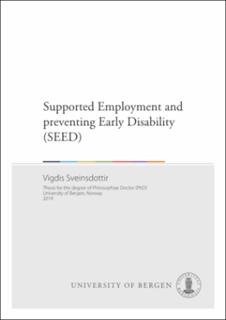| dc.description.abstract | Young adults who are not in education, training or employment (NEET) represent an international challenge that causes worry due to the potentially harmful health-effects of unemployment, and the economic costs for society. The NEET population includes those who are temporarily unemployed or inactive, as well as more marginalized groups at high risk of prolonged or lifelong disengagement. Being excluded from the labor market in early adulthood can have severe consequences for later work participation, and the diversity of the NEET population implies a need to focus on specific subgroups. In Norway, the share of young adults receiving permanent disability benefits has increased considerably during the last years. The main reason for early disability benefits in Norway are mental and behavioral disorders, and risk factors include socioeconomic factors such as low educational attainment. There is however little knowledge about the individuals who are at high risk, but have not yet reached the point of more permanent exclusion from the labor market. This thesis focuses on young adults with impaired work capability who are at risk of early work disability due to various social and health-related challenges. Studies of vocational rehabilitation of NEETs are scarce, and existing knowledge is insufficient to guide policy-makers and other stakeholders in efforts for this group. Furthermore, policies aimed at NEETs in general may be more appropriate for those who are ready to work, while failing to reach the most vulnerable groups. Individual Placement and Support (IPS) is a high-contact approach that is effective for patients with severe mental illness. It is based on clearly defined principles with a main focus on ordinary paid employment in the competitive labor market. IPS is effective across a range of demographic and clinical subgroups with severe mental illness, but there is limited evidence about the effectiveness of IPS in non-psychiatric populations. The aim of the thesis was to generate knowledge about young adults at risk of early work disability in Norway, and to investigate whether the Individual Placement and Support (IPS) model of supported employment may help this group enter the labor market. The aim of paper I was to plan and design a randomized controlled trial to evaluate the effectiveness of repurposing IPS to young adults at risk of early work disability due to various social or health-related problems. The trial was named Supported Employment and preventing Early Disability (the SEED-trial), and compared IPS to a control group that received traditional vocational rehabilitation using traineeships in sheltered businesses. Participants were NEETs, aged 18-29 years old, receiving temporary benefits, and had been considered eligible for traineeships in sheltered businesses. The primary outcome was competitive employment, defined as any paid employment in the competitive labor market during the first year after enrollment. Secondary outcomes included physical and mental health, health behaviors, and wellbeing. Survey data were collected at baseline, 6, and 12 months. The trial design also included long-term follow-up using register data for benefit recipiency, income, and education for five years after inclusion in the study, and a cost-benefit analysis. The aim of paper II was to investigate social and health-related characteristics in young adults at risk of early work disability in Norway, and what they believe may have caused their illness. The paper used baseline data from the 96 participants who were included in the SEED-trial. The majority were male, single, childless, and nearly half were living with their parent(s). Participants had relatively low educational attainment, and more than half reported hazardous drinking or active alcohol use disorders. The prevalence of psychological distress was high, which coincides with previous knowledge about the major reasons for early work disability in Norway. The most noteworthy findings with important implications for efforts targeting this group were however related to psychosocial stressors, including a high prevalence of bullying and exposure to violence. When participants who considered themselves to have an illness were asked about the reasons for their illness, the most common responses were also related to non-medical causes, especially relational problems such as loneliness and isolation. The aim of paper III was to evaluate the effectiveness of IPS versus traditional vocational rehabilitation for young adults at risk of early work disability, on outcomes of competitive employment, and physical and mental health and well-being. Findings showed that significantly more participants in the IPS group (48%) obtained competitive employment compared to participants in the control group (8%) during 12-month follow-up. The groups did generally not differ on health-related outcomes in unadjusted analyses, with a few exceptions. However, when adjusted for baseline and missing observations in post hoc analyses, the IPS group reported significantly better outcomes in anxiety, subjective health complaints, pseudoneurology, helplessness, hopelessness, and drug use at 6-month follow-up, and in level of disability, subjective health complaints, optimism about future well-being, helplessness, hopelessness, and drug use at 12-month follow-up. The findings of this thesis have several implications. In addition to underlining the importance of preventive measures to reduce social exclusion by bullying and early dropout, the findings suggest that there is need for a broader focus on psychosocial aspects in vocational rehabilitation of young adults at risk of early work disability. The findings that IPS was superior to the control condition in increasing competitive employment among this group of NEETs, and that IPS may also have beneficial effect on health, furthermore indicate that vocational rehabilitation for this group should be redirected from traditional sheltered approaches to individualized support in competitive work settings. The SEED-trial is also the first to show that IPS can be successfully repurposed to this new and vulnerable target group at risk of being excluded from working life before having established themselves on the labor market. | en_US |
